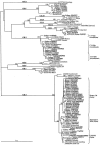Emergence of a new norovirus genotype II.4 variant associated with global outbreaks of gastroenteritis
- PMID: 16455879
- PMCID: PMC1392656
- DOI: 10.1128/JCM.44.2.327-333.2006
Emergence of a new norovirus genotype II.4 variant associated with global outbreaks of gastroenteritis
Abstract
Norovirus (NoV) is highly infectious and is the major cause of outbreak gastroenteritis in adults, with pandemic spread of the virus being reported in 1995 and 2002. The NoV genome is genetically diverse, which has hampered development of sensitive molecular biology-based methods. In this study we report on a nested reverse transcriptase PCR (nRT-PCR) that was designed to amplify the highly conserved 3' end of the polymerase region and the 5' end of the capsid gene of NoV genogroup II (GII). The nRT-PCR was validated with strains isolated from sporadic and outbreak cases between 1997 and 2004 in New South Wales, Australia. Phylogenetic analysis identified six genotypes circulating in New South Wales, GII.1, GII.3, GII.4, GII.6, GII.7, and GII.10, with GII.4 being the predominant genotype. In 2004, there was a marked increase in NoV GII activity in Australia, with a novel GII.4 variant being identified as the etiological agent in 18 outbreaks investigated. This novel GII.4 variant, termed Hunter virus, differed by more than 5% at the amino acid level across the capsid from any other NoV strain in the GenBank and EMBL databases. The Hunter virus was subsequently identified as the etiological agent in large epidemics of gastroenteritis in The Netherlands, Japan, and Taiwan in 2004 and 2005.
Figures

Similar articles
-
Characterization of norovirus strains in Australian children from 2006 to 2008: prevalence of recombinant strains.J Med Virol. 2011 Dec;83(12):2213-9. doi: 10.1002/jmv.22215. J Med Virol. 2011. PMID: 22012731
-
Recombinant norovirus implicated in gastroenteritis outbreaks in Hiroshima Prefecture, Japan.J Med Virol. 2008 May;80(5):921-8. doi: 10.1002/jmv.21151. J Med Virol. 2008. PMID: 18360906
-
Clinical relevance and genotypes of circulating noroviruses in northern Taiwan, 2006-2011.J Med Virol. 2014 Feb;86(2):335-46. doi: 10.1002/jmv.23728. Epub 2013 Sep 5. J Med Virol. 2014. PMID: 24009100
-
Worldwide molecular epidemiology of norovirus infection.Paediatr Int Child Health. 2012 Aug;32(3):128-31. doi: 10.1179/2046905512Y.0000000031. Paediatr Int Child Health. 2012. PMID: 22824658 Review.
-
The epidemiology of published norovirus outbreaks: a review of risk factors associated with attack rate and genogroup.Epidemiol Infect. 2012 Jul;140(7):1161-72. doi: 10.1017/S0950268812000234. Epub 2012 Mar 26. Epidemiol Infect. 2012. PMID: 22444943 Free PMC article. Review.
Cited by
-
Machine Learning and Imputation to Characterize Human Norovirus Genotype Susceptibility to Sodium Hypochlorite.Food Environ Virol. 2024 Dec;16(4):492-505. doi: 10.1007/s12560-024-09613-3. Epub 2024 Sep 11. Food Environ Virol. 2024. PMID: 39259473 Free PMC article.
-
Biological Specimen Banking as a Time Capsule to Explore the Temporal Dynamics of Norovirus Epidemiology.Viruses. 2023 Nov 24;15(12):2303. doi: 10.3390/v15122303. Viruses. 2023. PMID: 38140544 Free PMC article.
-
Trends on Human Norovirus Virus-like Particles (HuNoV-VLPs) and Strategies for the Construction of Infectious Viral Clones toward In Vitro Replication.Life (Basel). 2023 Jun 26;13(7):1447. doi: 10.3390/life13071447. Life (Basel). 2023. PMID: 37511822 Free PMC article. Review.
-
Norovirus: An Overview of Virology and Preventative Measures.Viruses. 2022 Dec 16;14(12):2811. doi: 10.3390/v14122811. Viruses. 2022. PMID: 36560815 Free PMC article. Review.
-
Global Burden and Trends of Norovirus-Associated Diseases From 1990 to 2019: An Observational Trend Study.Front Public Health. 2022 Jun 17;10:905172. doi: 10.3389/fpubh.2022.905172. eCollection 2022. Front Public Health. 2022. PMID: 35784210 Free PMC article.
References
-
- Ando, T., J. S. Noel, and R. L. Fankhauser. 2000. Genetic classification of “Norwalk-like viruses.” J. Infect. Dis. 181(Suppl.):S336-S348. - PubMed
-
- Burton-MacLeod, J. A., E. M. Kane, R. S. Beard, L. A. Hadley, R. I. Glass, and T. Ando. 2004. Evaluation and comparison of two commercial enzyme-linked immunosorbent assay kits for detection of antigenically diverse human noroviruses in stool samples. J. Clin. Microbiol. 42:2587-2595. - PMC - PubMed
Publication types
MeSH terms
Substances
Associated data
- Actions
- Actions
- Actions
- Actions
- Actions
- Actions
- Actions
- Actions
- Actions
- Actions
- Actions
- Actions
- Actions
- Actions
- Actions
- Actions
- Actions
- Actions
- Actions
- Actions
- Actions
- Actions
- Actions
- Actions
- Actions
- Actions
- Actions
- Actions
- Actions
- Actions
- Actions
- Actions
- Actions
- Actions
- Actions
- Actions
- Actions
- Actions
- Actions
- Actions
- Actions
- Actions
- Actions
- Actions
- Actions
- Actions
- Actions
- Actions
- Actions
- Actions
- Actions
- Actions
- Actions
- Actions
- Actions
- Actions
- Actions
- Actions
- Actions
- Actions
- Actions
LinkOut - more resources
Full Text Sources
Other Literature Sources
Medical

